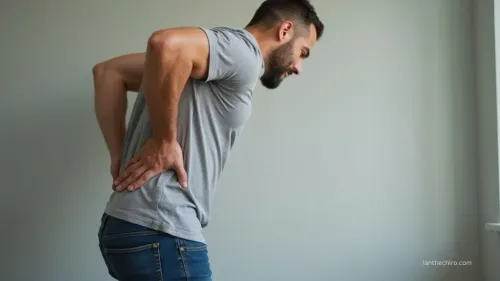Movement Medicine: How Wolff's Law, Davis's Law, and Hormesis Work Together for Optimal Health
You can build stronger bones and more resilient tissues by understanding how movement signals your body to adapt.
Wolff’s Law means weight-bearing exercise strengthens your bones; Davis’s Law shows that stretching and gentle load reshape and toughen soft tissues. The principle of hormesis tells you that regular, moderate stress, like daily movement, triggers powerful healing and repair. By moving intentionally each day, you’ll set the stage for lasting health.
Explore how to apply these strategies for ideal results.
Understanding Wolff’s Law: How Bones Respond to Stress

When you put your bones under regular mechanical stress, like lifting weights or engaging in weight-bearing exercise, they respond by becoming denser and stronger. This is the essence of Wolff’s Law: your bone adapts to the loads you place on it.
If you increase the load, your bones remodel internally, laying down more tissue and optimising their structure to better resist future stresses. This adaptation happens through a process called mechanotransduction, where your bone cells sense mechanical signals and convert them into biochemical responses, leading to growth and reinforcement.
On the other hand, if you’re inactive, your bones adapt in the opposite way, losing density and strength.
Davis’s Law: How Soft Tissues Adapt and Strengthen
Although often overlooked, the way your soft tissues, like ligaments, tendons, and fascia, adapt to movement is just as essential as bone health. According to Davis’s Law, soft tissue responds to sustained tension by realigning, lengthening, and remodeling itself for greater strength and flexibility.
When you consistently stretch or gently load these tissues, their fibers adapt, which helps prevent injuries and improve joint health. In contrast, immobilisation can cause soft tissue to shorten and weaken, making regular movement and stretching crucial for maintaining function.
This principle is why physical therapy emphasises progressive stretching, to guide remodeling and restore mobility after injury. By understanding and applying Davis’s Law, you empower yourself to actively support your body’s natural ability to heal, adapt, and thrive.
Harnessing Hormesis: The Power of Controlled Stress

While it might seem counterintuitive, exposing your body to small, controlled stressors can actually make you stronger and more resilient. This concept, called hormesis, is well-documented in scientific research.
Small, controlled stressors can strengthen your body and build resilience, a principle known as hormesis, supported by scientific research.
When you engage in regular, moderate exercise, you apply just enough stress to your bone and soft tissues to trigger adaptive responses. Your cells respond by ramping up repair mechanisms, producing growth factors and antioxidants that support regeneration and overall health.
For example, consistent weight-bearing exercise signals your bones to reinforce themselves, making them denser and less prone to injury.
The key is balance, mild, intentional stress strengthens your body, while too much can be harmful.
Practical Applications: Movement Strategies for Structural Health
By weaving purposeful movement into your daily routine, you tap into the body’s natural ability to adapt and thrive. Weight-bearing activities like walking, stair climbing, or resistance training actively stimulate bone health, harnessing Wolff’s Law by prompting your bones to remodel and strengthen in response to mechanical stress.
Vary your movements, changing directions, speeds, and loads, to expose bones and soft tissues to beneficial, dynamic strain. Physical therapy approaches often use progressive, controlled loading to target specific ligaments and tendons, supporting Davis’s Law and enhancing tissue flexibility and integrity.
Regular, moderate exercise induces hormesis, encouraging resilience without risk of injury. By combining these movement strategies, you foster ideal structural health, reduce injury risk, and support your body’s ongoing capacity for adaptation and repair.
Integrating Movement Medicine Into Daily Life

Even small changes to your daily routine can open the benefits of movement medicine, making structural health accessible no matter your schedule. Start by weaving short bouts of movement into your day, take the stairs, stretch during breaks, or do bodyweight exercise like squats and push-ups.
These actions stimulate bone remodeling, as Wolff’s Law describes, and reinforce soft tissue strength in line with Davis’s Law. Gentle, progressive exercise, such as brisk walking or yoga, applies mild stress that triggers hormetic adaptation, building resilience over time.
Don’t underestimate the power of consistency; varied, regular movement distributes strain, prevents disuse atrophy, and supports balanced tissue health. By intentionally integrating movement and exercise, you’ll optimise adaptation, recovery, and structural integrity, making movement medicine a practical part of daily living.
FAQs on Wolff’s Law, Davis’s Law, and Hormesis
How Is Wolff's Law Reflected in Adaptation to Physical Stressors in Humans?
When you regularly challenge your bones with weight-bearing activities, your body responds by making them stronger and denser. If you reduce physical activity, your bones weaken. This adaptive process, described by Wolff’s Law, empowers your bone health.
What Is Wolff's Law Including Why It Is Important?
Think of your bones like a bridge, add traffic, and it gets reinforced. Wolff’s Law means your bones strengthen when you challenge them. That’s why weight-bearing exercise is essential: you actively shape resilient, healthier bones for life.
What Is the Application of Wolff's Law?
You apply Wolff’s Law by engaging in weight-bearing exercises like walking or resistance training. These activities stimulate your bones to grow stronger and denser, helping you prevent osteoporosis, accelerate healing after injury, and maintain lifelong skeletal health.
How to Grow With Wolff's Law?
When you put your best foot forward with regular, weight-bearing exercise, you signal your bones to grow stronger over time. Science shows that progressive resistance and consistency help you build resilience and protect against bone loss.
Conclusion: Building Resilience Through Movement
When you move with intention, you’re not just exercising, you’re reshaping your body at every level. In fact, research shows regular physical activity can reduce your risk of chronic disease by up to 50%. By applying Wolff’s Law, Davis’s Law, and hormesis, you tap into your body’s innate power to adapt and thrive. Remember, every step and stretch is a step toward resilience.
Make movement your medicine, and you’ll build a foundation for lasting health.














